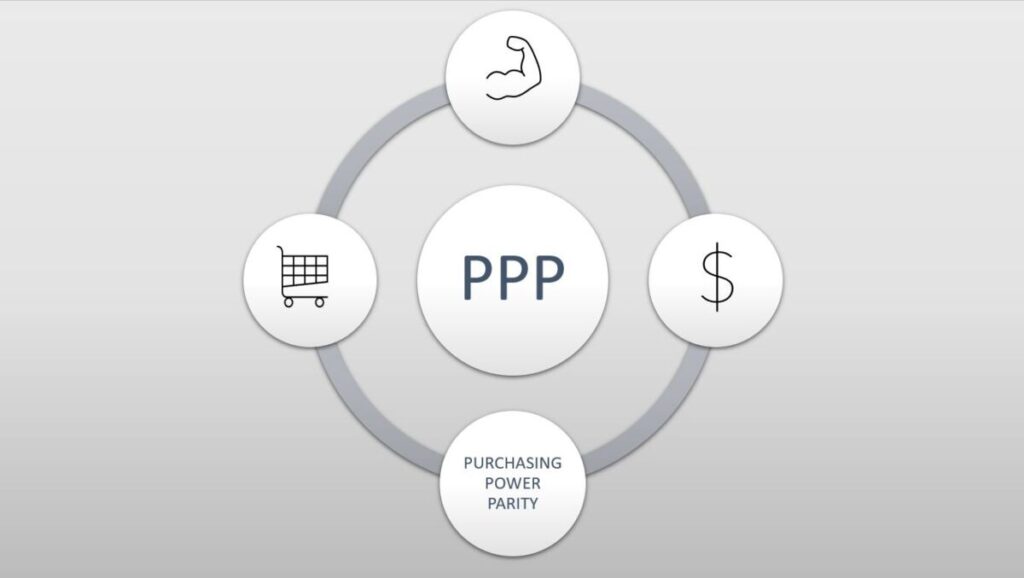Beginner-Friendly Guide | Read Time: 7 minutes
Key Takeaways
- Purchasing Power Parity (PPP) compares currencies based on the cost of a basket of goods, offering a clear view of how much each currency can actually buy.
- PPP-adjusted data is crucial for analyzing GDP, living standards, and economic performance globally.
- In the crypto market, PPP offers insight into how users in high-inflation or weak-currency countries use cryptocurrencies and stablecoins to preserve their purchasing power.

Introduction: Why PPP Matters
Why does a cup of coffee cost $10 in one country but only $2 in another? Enter Purchasing Power Parity (PPP) — a concept used by economists to measure the real value of currencies based on what you can actually buy with them.
PPP simplifies international comparisons by adjusting for price differences, giving a more accurate picture of wealth, cost of living, and economic well-being. In today’s globalized world — and especially in the decentralized world of crypto — PPP is more relevant than ever.

Table of Contents
How Does PPP Work?
At its core, PPP is based on the law of one price: if markets were perfectly efficient, the same product should cost the same in every country once exchange rates are considered.
Example:
If a smartphone costs $500 in the U.S. and ¥55,000 in Japan, PPP implies that $1 = ¥110. If the actual exchange rate deviates, it suggests one currency is overvalued or undervalued.
However, real-world factors like taxes, transportation costs, tariffs, and local demand distort prices. So instead of one product, economists compare a “basket of goods” — including food, clothing, housing, and utilities — to calculate the true value of a currency in terms of what it can buy domestically.
Why Is PPP Important?
1. Adjusting GDP for Accuracy
PPP is essential when comparing Gross Domestic Product (GDP) across countries. A country with low nominal GDP might look much wealthier when adjusted for its lower cost of living.
For example, India’s GDP per capita may seem low in dollar terms. But on a PPP basis, it reflects stronger purchasing power and better living standards.
2. Comparing Cost of Living
Ever wondered if your salary goes further in Thailand or Canada? PPP helps compare living standards, showing what people can actually afford in different economies.
3. Detecting Currency Manipulation
Governments may artificially set exchange rates to present a strong economic front. PPP exposes when a currency is overvalued or undervalued by comparing it to real purchasing power.
4. Forecasting Long-Term Exchange Rates
Short-term exchange rates are volatile. But over the long term, they tend to move toward PPP. That’s why economists use PPP as a benchmark for currency predictions.
Real-World Examples: Big Macs and Beyond
One famous application is the Big Mac Index, created by The Economist. Since Big Macs are nearly identical worldwide, their local price helps assess currency value.
If a Big Mac costs $5 in the U.S. and $3 in India, the Indian rupee may be undervalued.
Other indexes like the iPad Index and KFC Index also use standardized global products to measure PPP in a fun, relatable way.
Challenges and Limitations of PPP
Despite its usefulness, PPP has drawbacks:
- Quality Differences: Products may differ in quality, even if they seem similar.
- Non-Traded Goods: Services like haircuts or rent can’t be traded globally, and their prices vary widely.
- Inflation: PPP assumes price stability, which doesn’t hold in fast-changing economies.
- Cultural Preferences: The basket of goods isn’t the same for everyone; consumption patterns vary by region.
PPP in the Context of Cryptocurrency
PPP isn’t directly tied to crypto, but the implications are huge:
Global Accessibility
Cryptocurrencies like Bitcoin and Ethereum aren’t bound by borders. But users from countries with weak currencies face higher barriers to entry. Understanding PPP helps explain why crypto adoption is higher in inflation-prone countries like Argentina or Nigeria.
Stablecoins as Financial Tools
Stablecoins (e.g., USDT, USDC) are pegged to fiat currencies and offer a hedge against local currency devaluation. In PPP terms, stablecoins preserve purchasing power, especially in unstable economies.
Decision-Making and Risk
Understanding PPP allows users to evaluate whether converting local currency into crypto is beneficial — both as a store of value and a tool for remittance, trade, or saving.
Closing Thoughts
Purchasing Power Parity is more than an economic theory — it’s a lens to view the global economy more fairly. From comparing GDP to making sense of crypto adoption in emerging markets, PPP equips us with tools to decode global prices, wages, and living standards.
Whether you’re an economist, investor, or crypto enthusiast, understanding PPP helps you make smarter decisions in a world where currencies — and cryptocurrencies — play a defining role in financial freedom.
Join MEXC and Get up to $10,000 Bonus!



